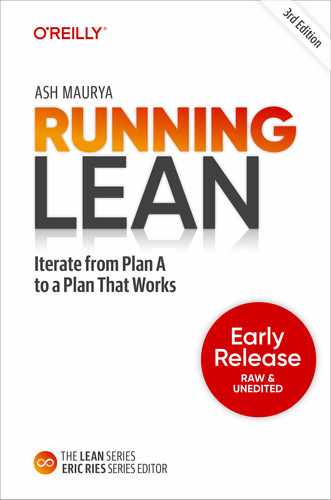We're building more products today than ever before, but most of them fail — not because we can't complete what we want to build but because we waste time, money, and effort building the wrong product. What we need is a systematic process for quickly vetting product ideas and raising our odds of success. That's the promise of Running Lean. In this inspiring book, Ash Maurya takes you through an exacting strategy for achieving a product/market fit for your fledgling venture. You'll learn ideas and concepts from several innovative methodologies, including the Lean Startup, business model design, design thinking, and Jobs-to-be-Done. This new edition introduces the continuous innovation framework and follows one entrepreneur's journey to uncover, design, and build a product that matters.
Table of Contents
- Introduction
- A Tale of Two Entrepreneurs
- A Build-First or Investor-First Approach is Backwards
- 1 year ago…
- Off to the races…
- 6 months later…
- Catch-22
- A Traction-first Approach is the New Way Forward
- What Determines Success Isn’t Differing Skill Sets But Differing Mindsets
- The stakes are much higher this time
- Speed of learning is the new unfair advantage.
- Succeeding in the new world requires new mindsets
- You Can’t Afford to Wait For An Idea Whose Time Has Come
- Steve learns about Minimum Viable Products
- Don’t Start With an MVP
- There is a Systematic Approach to Entrepreneurship
- About Me
- How This Book is Organized?
- PART 1: MODEL
- Part 2: PRIORITIZE
- Part 3: TEST
- Is This Book For You?
- Practice Trumps Theory
- I. Model
- 1. Deconstruct Your Idea into a Business Model
- Sketching Your First Lean Canvas
- Sketch a canvas in one sitting.
- Avoid group think.
- Know that it’s okay to leave boxes blank
- Follow the 1-page rule
- Think in the present
- Remember there is no right order for sketching a Lean Canvas
- Customer Segments
- Distinguish between customers and users.
- Model multiple perspectives
- Home in on early adopters
- Problem
- List the top one to three problems.
- List existing alternatives.
- Steve Tackles the Customer Segment/ Problem Quadrant
- Unique Value Proposition
- Connect to your customer’s #1 problem.
- Target early adopters.
- Focus on outcomes.
- Keep it short.
- Answer: what, who, and why.
- Create a high-concept pitch.
- Steve crafts his UVP
- Solution
- Steve defines a Solution
- Channels
- Steve outlines some possible paths to customers
- Revenue Streams and Cost Structure
- Revenue Streams
- Cost structure
- Steve thinks through his cost structure and revenue streams
- Key Metrics
- Happy customers get you paid.
- Steve aligns on his key metrics
- Unfair Advantage
- What do you do if you don’t have an unfair advantage on day one?
- Steve ponders his unfair advantage story
- Refine Your Lean Canvas
- So how do you avoid the Goldilocks problem?
- How do you know when to split your Lean Canvas?
- Steve Splits His Big Idea Canvas into Specific Variants
- Now It’s Your Turn
- 2. Stress Test Your Business Model
- Stress Testing Desirability
- The problem with problems
- The Innovator’s Gift
- Steve Realizes He Has a Hammer Problem
- Run the Innovator’s Gift Test on Your Idea
- Stress Testing Viability
- Up for some Excel magic?
- What is Traction?
- Don’t create a financial forecast. Start with a Fermi Estimate instead.
- 1. Set a Minimum Success Criteria Constraint
- 2. Test Your Business Model Against Your Minimum Success Criteria Constraint
- 3. Adjust Your Business Model
- Isn’t this just funny math?
- Run the Back-of-the-envelope Test on Your Idea
- Stress Testing Feasibility
- 3. Pitch Your Business Model
- The Different Worldviews of an Idea
- The Story We Tell Ourselves
- The Investor Story
- The Customer Story
- The Advisor Story
- The Competitor Story
- Start With An Elevator Pitch
- An elevator pitch is NOT about your solution
- An elevator pitch is the beginning of a good story
- It’s time to craft your elevator pitch
- Outline Your Origin Story
- Craft a 5-minute Business Model Story Pitch
- Get Feedback on Your Business Model Story Pitch
- Steve Reviews His Business Model Story Pitch With Mary
